Fact Sheet FS1101
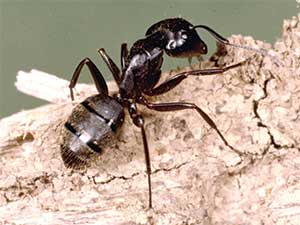
Picture 1: Camponotus pennsylvanicus
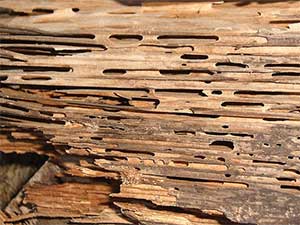
Picture 2: Carpenter ant damage to tree.
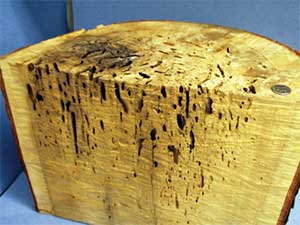
Picture 3: Carpenter ant damage to wood.
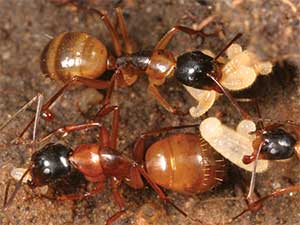
Picture 4: Camponotus americanus
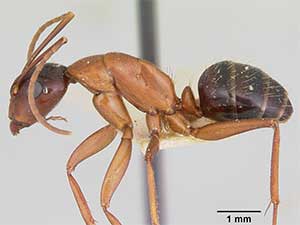
Picture 5: Camponotus castaneus
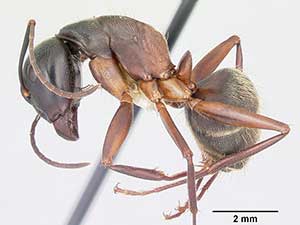
Picture 6: Camponotus chromaiodes
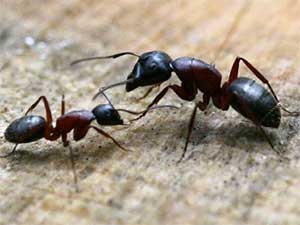
Picture 7: Camponotus herculeanus
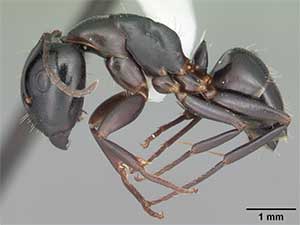
Picture 8: Camponotus nearcticus
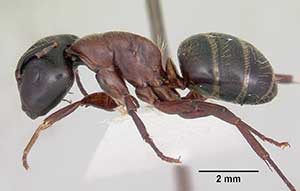
Picture 9: Camponotus novaeboracensis
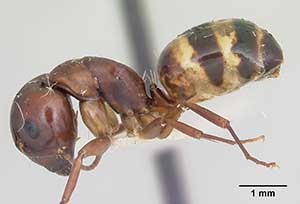
Picture 10: Camponotus subbarbatus
Carpenter ants are a group of ant species in the genus Camponotus. They nest in wood and create smooth tunnels and galleries, hence, the name carpenter ants. Eight carpenter ant species occur in the northeastern U.S. They are:
The most common species is the black carpenter ant. It is among the largest of the ant species found in urban environments.
Identification
All carpenter ants have a characteristic arch-shaped thorax when viewed from the side (Picture 1). Black carpenter ants can be easily identified by their large size and uniform black color. A colony can have different sizes of workers (major, media, minor workers). Worker sizes range from 6 to 13 mm (¼ to 5/8 inch) in length. The queen is slightly larger than the major workers and has a much smaller head and larger abdomen. Five other species: C. americanus, C. chromaiodes, C. castaneus, C. herculeanus, and C. novaeboracensis are similar in size to the black carpenter ant, but their colors are not uniformly black. The other two species, C. nearcticus and C. subbarbatus, are much smaller, ranging from 4.5 to 7.5 mm in length (1/8 to 5/16 inch). Carpenter ant damage (Picture 2) is different from termite damage in that: 1) the ant tunnels across the wood's grain whereas termite tunnels always follow the wood's grain; 2) ant tunnels are clean, termite tunnels are covered with mud; 3) piles of dust are often seen near the ant nest site.
Biology and Behavior
Carpenter ants undergo complete development (egg, larva, pupa, adult). The pupae are enclosed in cocoons and are often misnamed "ant eggs." A colony includes one queen and several thousands of workers. Only the queen produces eggs. Each worker can live 4 to 5 years. Many workers do not live that long due to predators or human activities. The queen can live as long as 15 years. It takes about two months for eggs to develop into adults. A new colony requires 3 to 6 years to mature and to produce 200 to 400 winged forms or "swarmers" every year. Swarmers are reproductive adults that mate outside of the nest. Males die shortly after mating. Females shed their wings and find a new nest site.
Usually a new queen prefers to establish a nest in wood that is moist or partially decayed; however, she may enter an existing dry cavity. Common nest sites inside structures include hollow porch posts, wood siding, floor joists, doors, window frames, voids in the ceiling of porches and breezeways, wood in contact with soil, and wood that has become moist due to faulty plumbing. Once the nesting site is selected, the queen seals the entrance and proceeds to deposit 15 to 20 eggs. The queen uses its stored nutrients to feed the first batch of larvae.
After the first generation reaches maturity, the workers open the chamber and begin to forage for food. Carpenter ants feed on sugar, dead insects, honeydew excreted by aphids, plant exudates, and dead animals. They may prey on live insects. Carpenter ants are primarily nocturnal insects and often build foraging trails to connect their nests and the food source. Foraging workers can be found around or inside homes searching for food and become nuisance pests in our homes. In the northeast, carpenter ants become active in May and cease activity in October. Peak activity occurs in July. As their colony size expands, carpenter ants will establish satellite colonies in nearby trees and structures. Thereby, structures that are surrounded by large trees are often targets of carpenter ant infestations. Carpenter ants can travel more than 100 yards to search for food and establish satellite colonies.
Economic Significance
Carpenter ants are among the top five pest ant groups in the United States. They cause damage to structures through their nesting behavior. Yet, carpenter ant damage rarely compromises the structural integrity of a building. Carpenter ants do cause damage to utility poles and urban shade trees. In New Jersey, 75% of urban shade trees sampled in 1981–1982 were infested. Carpenter ant excavation not only weakens trees, but also leads to infestations by other pests and pathogens. Foraging ants or swarmers are a nuisance when they appear inside homes.
Prevention and Control
Leaky pipes and other moisture problems should be eliminated to avoid carpenter ants establishing nests in homes. Firewood should be placed off the ground and away from the house. Vegetation surrounding the structure should be cleared or cut back to eliminate any potential entry points into a structure.
The first and most important step to control existing carpenter ant infestations is to locate their nests. The presence of sawdust indicates the presence of a nest nearby. Ant nests can also be located by placing diluted honey, 25% sugar water (on a cotton ball or in a small container), or crushed insects at several spots around the house or beside large trees after sunset. Inspect the bait after 1–2 hours. Once the ants find the bait, large numbers usually emerge near the bait. When they do, follow the ant trails to locate the nest sites.
Baits containing fipronil, hydramethylnon, thiamethoxam, indoxacarb, abamectin, and boric acid are highly effective against carpenter ants. Foraging ants will bring the bait into their nests, regurgitate its stomach content to other ants, resulting in the death of the whole colony. Several different types of baits (liquid and solid bait) should be offered to determine which bait the ants prefer. Place the baits close to the ant nest or their foraging trails to ensure the ants will find them. Monitor the acceptance of the toxic baits for several days. Liquid bait needs to be replenished every few days.
Household insecticide sprays can be applied to the exterior foundation, around door and window frames, under the lower edge of siding, tree stumps, and base of tree trunks. Trails should also be treated. However, sprays usually do not kill the whole colony unless they are applied directly to the nest. Professional insecticide sprays containing fipronil are very effective for controlling carpenter ants. Insecticide dust is effective in treating ant nests in wall voids; however, it is not necessary to treat all wall voids. Treatment of the wires and pipes within accessible wall voids will usually be sufficient. If only a few ants are observed from time to time and there is no nest in the structure, then they can be crushed underfoot. Avoid spraying insecticides inside homes since they will not eliminate the ants unless the spray is applied directly to a nest inside a structure.
Complete elimination of an ant colony requires several weeks because time is required to spread toxicants to non-foraging worker ants, the brood, and the queen. It is possible that after chemical treatment, ant activities will immediately cease, then resume after a few weeks. Follow-up evaluation as well as chemical and non-chemical treatments is usually necessary to achieve satisfactory control of carpenter ant infestations.
Reference
Mention or display of a trademark, proprietary product, or firm in text or figures does not constitute an endorsement by Rutgers Cooperative Extension and does not imply approval to the exclusion of other suitable products or firms.
Photo credits: Clemson University (Pictures 1 and 2); Michael Scharf (Picture 3); Gary Alpert (Picture 4), April Nobile (Pictures 5, 6, 8, 9, and 10); IN Nielsen (Picture 7).
February 2019
Copyright © 2024 Rutgers, The State University of New Jersey. All rights reserved.
For more information: njaes.rutgers.edu.
Cooperating Agencies: Rutgers, The State University of New Jersey, U.S. Department of Agriculture, and Boards of County Commissioners. Rutgers Cooperative Extension, a unit of the Rutgers New Jersey Agricultural Experiment Station, is an equal opportunity program provider and employer.

